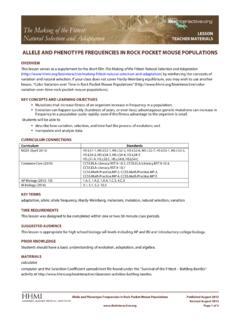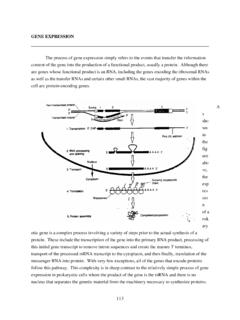Transcription of MODELING THE REGULATORY SWITCHES OF THE PITX1 GENE …
1 The Making of the Fittest: Evolving SWITCHES , Evolving Bodies TEACHER MATERIALS. MODELING THE REGULATORY SWITCHES OF THE PITX1 gene . IN STICKLEBACK FISH. OVERVIEW. This hands-on activity supports the short film, The Making of the Fittest: Evolving SWITCHES , Evolving Bodies, and aims to help students understand eukaryotic gene regulation and its role in body development using the example of a well-studied gene called PITX1 . Students will interpret molecular diagrams of eukaryotic gene transcription to familiarize themselves with the molecular components and mechanisms responsible for regulating gene transcription. They will then create models showing how PITX1 gene transcription is regulated in two morphologically different populations of stickleback fish. KEY CONCEPTS AND LEARNING OBJECTIVES. Virtually all cells in the body have the same genetic makeup,* but not all genes are expressed in all tissues at all times.
2 Whether a gene is expressed is dependent on the REGULATORY SWITCHES that the gene possesses and the activators or repressor proteins present in that cell. Activators bind to REGULATORY SWITCHES in a sequence-specific manner. The binding of the activators to the SWITCHES activates transcription. Some genes, especially genes involved in body development, have multiple SWITCHES . Each switch independently regulates the expression of the gene in different parts of the body at different times in the animal's life cycle. The presence of multiple SWITCHES enables the same gene to be used many times in different contexts and thus greatly expand the functional versatility of individual genes. Mutations in REGULATORY SWITCHES affect expression of a particular gene in a particular tissue without affecting the gene 's protein product. Changing the expression of a gene involved in body development can have profound effects in shaping the body.
3 * There are some notable exceptions: (1) Mature red blood cells have no DNA. (2) Germ line cells (sperm and egg) have half the genetic material. (3) B cells, which are part of the immune system, have DNA that has been rearranged to make antibodies. (4) Cells acquire somatic mutations. In some cases, these mutations confer a selective advantage for that cell and that mutation will be fixed in a set population of cells, like in the case of cancer cells. At the end of this activity, students should be able to: Correctly interpret visual representations of eukaryotic gene transcription. Contrast how mutations in REGULATORY SWITCHES differ from mutations in coding regions of genes. Construct models that accurately represent the regulation of PITX1 transcription in marine and freshwater stickleback fish. KEY TERMS. transcription, eukaryotic gene regulation, REGULATORY SWITCHES , enhancers, or cis- REGULATORY regions, activators, repressors, general transcription factors, mediators, promoters, RNA polymerase, phenotype, evolution, natural selection, mutation, adaptation, genes, proteins, protein-coding region, mutations.
4 TIME REQUIREMENT. This lesson is designed for two 50-minute class periods (see Teaching Tips for more information). Depending on the level of students'. background knowledge, certain parts of the activity may be eliminated or may be done as a whole-class activity. SUGGESTED AUDIENCE. This lesson is aimed toward high school biology (general bio and AP/IB) and introductory college biology. RECOMMENDED STUDENT BACKGROUND KNOWLEDGE. Students should be familiar with basic genetics and the central dogma. Some knowledge about how lac and trp operons work would be helpful. In addition, students should understand the role of genetic variation in a species in natural selection and evolution. MODELING the REGULATORY SWITCHES of the PITX1 gene in Stickleback Fish Published April 2013. Page 1 of 12. The Making of the Fittest: Evolving SWITCHES , Evolving Bodies TEACHER MATERIALS.
5 MATERIALS. Students will need: 4 white pipe cleaners, 12-18 inches long (or 18-inch white twine). Magic markers (blue, green, red, yellow, purple). Scotch tape Poster board or 4 sheets of x 11 paper Any items that can represent proteins. Any types of materials that come in different colors can be used. See Teaching Tips for ideas. Ruler Scissors (optional). TEACHING TIPS. Key Points to Emphasize: Students may wonder why PITX1 is expressed in such diverse tissues. This is because the PITX1 gene contains multiple REGULATORY SWITCHES that allow for transcription of that gene in multiple tissues. The expression of PITX1 is important in various tissues because the PITX1 protein is itself a REGULATORY protein that serves many roles in the development of the fish. PITX1 controls the expression of multiple genes, not just those responsible for forming the hind limb.
6 In addition, students should recognize that some activators and repressors are present in multiple tissues. Approximately 5-10% of the human genome encodes REGULATORY proteins which act in different combinations to produce a great diversity of gene expression patterns. When students think of cell-type-specific proteins, they may automatically think of structural proteins like insulin in pancreatic cells, or myosin proteins in muscle cells. Remind students that cells also contain REGULATORY proteins, like PITX1 . The combination of both structural and REGULATORY proteins defines the cell type. Lead students to understand that the expression of activators that activate PITX1 transcription (for example, the activator that binds the pelvic switch) is also under REGULATORY control. Thinking about development raises chicken-or- egg questions. Although the development of a complex animal from a single cell is not fully understood, great progress has been made in recent decades to understand how different sets of genes move the development of an embryo through different stages to maturity.
7 These processes involve messenger RNA and proteins packed into the egg, and dividing cells having positional information about where they are in the developing embryo. Students are encouraged to read more about embryology, development, and differential gene expression . The film uses the term REGULATORY SWITCHES . Some textbooks will refer to them as enhancers. Procedural Tips: Have students work in groups of two or three. A nice animation of eukaryotic gene transcription can be found at to use as a supplemental resource. Note that the diagram in the animation looks different from the ones used in the film. Make sure that students are comfortable with looking at a variety of schematic illustrations used to represent similar molecular processes. You may want to show students the film the day before or assign it as homework to provide enough time to complete Parts 1 and 2.
8 In Part 3, have your students tape the models onto a poster board or on four sheets of x 11 inch paper. Alternatively, your students can take digital photographs of their models and submit them for review. Be sure to instruct your students on how they should submit the work they do in Part 3. Students can use different types of materials ( , colored stickers, Play-Doh, Legos, beads, etc.) to model the proteins in Part 3. The proteins needed for this activity are listed below. Suggested colors are in parentheses. Provide students with four sets of each of the proteins, although not every protein will be used: o RNA polymerase (purple). o Pelvic switch binding activator (green). o Jaw switch binding activator (red). o Pituitary switch binding activator (yellow). This piece will not be used in the activity, but you may want to provide it for students as a red herring.
9 You may discuss with your students where this activator would bind and in which tissues you might find it. o General transcription factors (optional, blue). o Mediators (optional, orange). MODELING the REGULATORY SWITCHES of the PITX1 gene in Stickleback Fish Page 2 of 12. The Making of the Fittest: Evolving SWITCHES , Evolving Bodies TEACHER MATERIALS. REFERENCES. Carroll , Prud'homme B., and Gompel N. (2008). Regulating Evolution. Scientific American, May 2008: 60-67. ANSWER KEY. PART 1: REVIEWING THE REGULATION OF EUKARYOTIC gene TRANSCRIPTION. 1. Figure 1 is a diagram, similar to the one shown in the film (8:00-8:34), showing key components of gene transcription. Label the boxes in Figure 1 with the letters a-e, which correspond to the terms listed below. For example, write letter a in the box pointing at the coding region of a gene . a. Protein-coding region b.
10 REGULATORY SWITCHES (or enhancers). c. Promoter d. mRNA. e. RNA polymerase b d e c a 2. Describe the function of REGULATORY SWITCHES . (Note: Some textbooks refer to REGULATORY SWITCHES as enhancers.). REGULATORY SWITCHES are regions of DNA that can be bound by a particular activator or repressor in a sequence- specific manner. It can either be near the coding region or many megabases away. The switch controls the transcription of genes in different tissues and at different times in development. 3. gene transcription is a complex process that involves the interactions of proteins and REGULATORY regions of DNA. The animation in the film (8:00-8:24) and Figure 1 show some of the factors involved but not all. In the cell, a number of proteins bind to different regions on the DNA to regulate gene transcription. Use your textbook to learn about the proteins involved in eukaryotic gene transcription.













